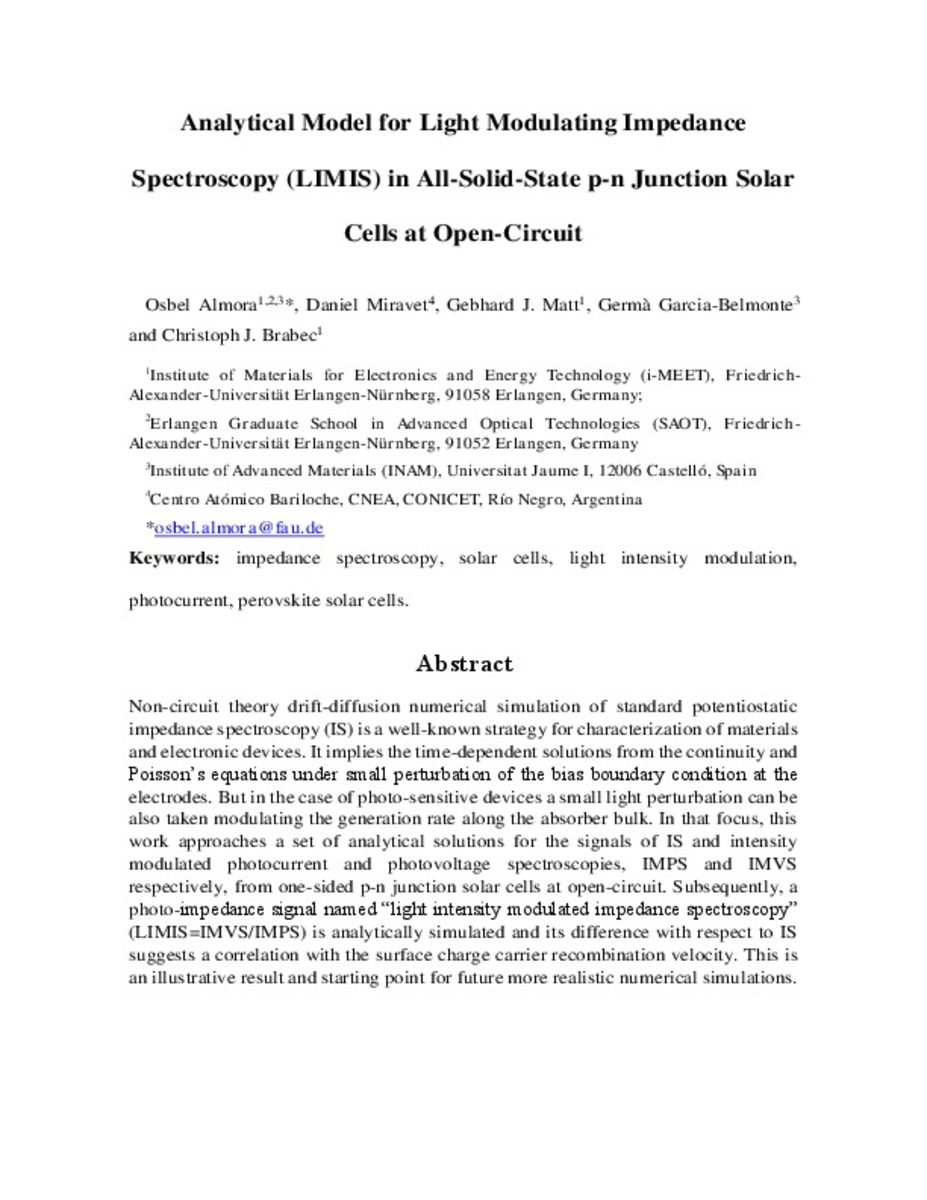| dc.contributor.author | Almora Rodríguez, Osbel | |
| dc.contributor.author | Miravet, Daniel | |
| dc.contributor.author | Matt, Gebhard J. | |
| dc.contributor.author | Garcia-Belmonte, Germà | |
| dc.contributor.author | Brabec, Christoph J. | |
| dc.date.accessioned | 2020-10-08T08:14:20Z | |
| dc.date.available | 2020-10-08T08:14:20Z | |
| dc.date.issued | 2010-01-02 | |
| dc.identifier.citation | O. Almora, D. Miravet, G. J.Matt, G. Garcia-Belmonte, and C. J. Brabec, "Analytical model for light modulating impedance spectroscopy (LIMIS) in all-solid-state pn junction solar cells at open-circuit". Appl. Phys. Lett. 116, 013901 (2020); https://doi.org/10.1063/1.5139571 | ca_CA |
| dc.identifier.issn | 0003-6951 | |
| dc.identifier.issn | 1077-3118 | |
| dc.identifier.uri | http://hdl.handle.net/10234/189918 | |
| dc.description.abstract | Potentiostatic impedance spectroscopy (IS) is a well-known tool for characterization of materials and electronic devices. It can be complemented by numerical simulation strategies relying on drift-diffusion equations without any equivalent circuit-based assumptions. This implies the time-dependent solutions of the transport equations under small perturbation of the external bias applied as a boundary condition at the electrodes. However, in the case of photosensitive devices, a small light perturbation modulates the generation rate along the absorber bulk. This work then approaches a set of analytical solutions for the signals of IS and intensity modulated photocurrent and photovoltage spectroscopies, intensity modulated photocurrent spectroscopy (IMPS) and intensity modulated photovoltage spectroscopy (IMVS), respectively, from one-sided p-n junction solar cells at the open-circuit. Subsequently, a photoimpedance signal named “light intensity modulated impedance spectroscopy” (LIMIS = IMVS/IMPS) is analytically simulated, and its difference with respect to IS suggests a correlation with the surface charge carrier recombination velocity. This is an illustrative result and the starting point for future more realistic numerical simulations.
We acknowledge the funding support from the Ministerio de-Ciencia, Innovación y Universidades of Spain under project (No. MAT2016-76892-C3-1-R). O.A. acknowledges the financial support from the VDI/VD Innovation + Technik GmbH (Project-title: PV-ZUM) and the SAOT funded by the German Research Foundation (DFG) in the framework of the German excellence initiative. | ca_CA |
| dc.format.extent | 6 p. | ca_CA |
| dc.format.mimetype | application/pdf | ca_CA |
| dc.language.iso | eng | ca_CA |
| dc.publisher | American Institute of Physics | ca_CA |
| dc.relation.isPartOf | Applied Physics Letters, 2020, vol. 116, no 1 | ca_CA |
| dc.rights.uri | http://rightsstatements.org/vocab/CNE/1.0/ | * |
| dc.subject | partial differential equations | ca_CA |
| dc.subject | diffusion current | ca_CA |
| dc.subject | charge recombination | ca_CA |
| dc.subject | P-N junctions | ca_CA |
| dc.subject | computer simulation | ca_CA |
| dc.subject | light sensitive materials | ca_CA |
| dc.subject | electrochemical impedance spectroscopy | ca_CA |
| dc.subject | solar cells | ca_CA |
| dc.subject | transport properties | ca_CA |
| dc.title | Analytical model for light modulating impedance spectroscopy (LIMIS) in all-solid-state p-n junction solar cells at open-circuit | ca_CA |
| dc.type | info:eu-repo/semantics/article | ca_CA |
| dc.identifier.doi | https://doi.org/10.1063/1.5139571 | |
| dc.relation.projectID | Ministerio de Ciencia, Innovación y Universidades of Spain: MAT2016-76892-C3-1-R; VDI/VD Innovation thorn Technik GmbH; German Research Foundation (DFG) | ca_CA |
| dc.rights.accessRights | info:eu-repo/semantics/openAccess | ca_CA |
| dc.relation.publisherVersion | https://aip.scitation.org/doi/full/10.1063/1.5139571 | ca_CA |
| dc.type.version | info:eu-repo/semantics/publishedVersion | ca_CA |







